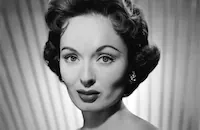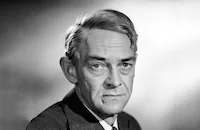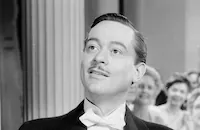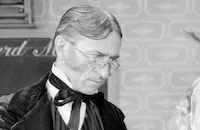Top O' the Morning

Brief Synopsis
Cast & Crew
David Miller
Bing Crosby
Ann Blyth
Barry Fitzgerald
Hume Cronyn
Eileen Crowe
Film Details
Technical Specs

Synopsis
In a small town near Cork, Ireland, civic guard Sergeant Briany McNaughton alerts his assistant, Hughie Devine, that the famous Blarney Stone has been stolen from the castle. This marks a big day for the village, as there has been no comparable crime in over thirty years. When Briany and Hughie investigate, they learn that villager Cormac Gillespie was seen near the castle the night before. Chief Inspector Fallon, from the Irish police force, orders Briany off the case because he does not consider him a professional, but Briany nevertheless determines to solve the crime. Meanwhile, in New York City, insurance investigator Joe Mulqueen is assigned to work undercover to find the Blarney Stone because his parents were Irish and his company insured the Stone for $500,000. Joe spends his first day in Ireland near Blarney Castle posing as a painter, and is befriended by some boys, who introduce him to Briany's beautiful daughter Conn, as she washes clothes in the castle's stream. Conn is stunned by Joe's presence, as he seems to fulfill a well-known prophecy about the theft of the Stone. However, suspicious Hughie arrests Joe and brings him to Briany for questioning. Although they lock Joe up when he refuses to give them any information about why he is there, they release him after he wins them over by singing an Irish ballad. Although Briany considers Joe a prime suspect, he invites him to his house for a party. That night at the party, Conn consults with wise woman Biddy O'Devlin, who is the keeper of the Stone's legend, and confirms that so far, Joe has fulfilled the conditions of the prediction, down to the coat he is wearing that night, and the fact that Conn is falling in love with him. When Joe returns from the party, he finds Briany and Hughie searching his room, and they learn that Joe is an investigator and hear his dictaphone recording, in which he says that Briany is not effective. Briany considers throwing Joe out of town but resists when he hears about the insurance company's $5,000 reward. Although everyone suspects that Cormac is the thief, Fallon tells Joe that the only fingerprints found on the castle wall belong to Hughie. Joe becomes more suspicious of the deputy when Hughie shows little remorse after his only relative dies in a cart accident. Joe starts to link together the accidents and recent unusual events that have been blamed on the theft, and formulates a secret plan with Fallon. One night, Joe and Conn enjoy their first kiss, but their joy is crushed when Briany arrives home with news that Fallon has fired him because Joe intimated that he might impede their investigation. Conn throws Joe out because he deceived her about his work, and because she hoped her father would find the Stone in order to restore his pride. Biddy warns her that the predictions indicate that the stranger of legend will be killed in the Killeen forest if his loved one abandons him. The next day, Joe investigates the site where Hughie's cousin died and realizes from tracks in the ground that someone tipped the cart over while it was stationary. Joe insists that Briany be reinstated, and arranges to meet Fallon and Briany that night at Biddy's cabin in the Killeen woods. Biddy then tells the police that the Stone was stolen to cover up the murder of Hughie's cousin. Everyone deserts Biddy to chase Cormac when he suddenly appears, but Hughie is disturbed by a comment Biddy made about his soul, and knocks out the boy sentry, Pearse O'Neill, to get her alone. Hughie is about to strangle Biddy when Joe and Briany stop him, and he reveals that he murdered his cousin for the money. Hughie is arrested, and before he is taken away, he vows never to reveal where he hid the Stone. Biddy realizes that although Joe did not die, the final prediction has come true, as it says that the singer, who is Pearse, will be struck down by violence, and the song will not be finished by a man. Pearse revives and everyone wanders away from Biddy's cabin, taking a path past a 700-year-old chapel. When Briany sits down upon a large stone that moves, Conn marvels that a stone set so long ago would suddenly come loose. Joe realizes that Briany has discovered the Blarney Stone, and Briany is now hailed as a hero.

Director

David Miller
Cast

Bing Crosby

Ann Blyth

Barry Fitzgerald

Hume Cronyn
Eileen Crowe

John Mcintire
Tudor Owen
Jimmy Hunt
Morgan Farley

John Eldredge
John "skins" Miller
John Costello
Dick Ryan
Bernard Cauley
Paul Connelly
John O'brien
Gus Taillon
Mary Field

Olin Howlin
G. Pat Collins
Laura Elliot
John Sheehan
Dick Keene
Edward Emerson
Murray F. Yeats
Pat Lane
Gene Ackerman
Kathleen Kennedy
Jimmy O'brien
William O'leary
Crew
Edmund Beloin
Richard Breen
Henry Bumstead
Johnny Burke
Sam Comer
James Cottrell
Mary Kay Dodson
Robert Emmett Dolan
Hans Dreier
Farciot Edouart
Don English
Gene Garvin
Harry Hogan
Gordon Jennings
Emile Kuri
Joseph J. Lilley
Lionel Lindon
Curtis Mick
Sidney Perell
Eddie Prinz
William Rand
Gertrude Reid
Oscar Rudolph
Troy Sanders
Arthur Schmidt
Dominic Seminerio
Arthur Shields
Van Cleave
James Van Heusen
Robert L. Welch
Wally Westmore
Stanley Williams
Philip Wisdom

Film Details
Technical Specs

Articles
Top o' the Morning
As writer Ruth Barton later observed in her book Acting Irish in Hollywood, "All three films establish similar personae for their two leads: Fitzgerald is the crusty old Irishman who resists change and is losing the authority he has held in a small community; Crosby is a modernizer who must learn to win over the trust of the older man as he solves the crisis his old-fashioned leadership has been unable to prevent. The films balance change against continuity, reserving their most sentimental moments for depictions of the 'old ways' while still insisting on the need for some limited modernization."
Top o' the Morning casts Crosby as an American insurance investigator who arrives in Ireland to look into the theft of the Blarney Stone from its namesake castle. To keep his identity secret, he poses as an artist. Fitzgerald, meanwhile, plays a local constable who sees the theft as a chance to establish himself as a hotshot detective; he also has a lovely lass of a daughter, played by 20-year-old Ann Blyth, with whom Crosby falls in love. (Blyth got the role after 17-year-old Deanna Durbin turned it down in favor of retirement.) Along the way, Bing croons several Irish folk tunes as well as two new songs by Johnny Burke and James Van Heusen: "When Irish Eyes are Smiling" and the title tune.
The picture was the fourth to be directed by David Miller, who had transitioned to features after a long career as an assistant editor and shorts director at MGM. His last short subject, the 1946 Seeds of Destiny, about the plight of children in war-torn Europe, had won the Academy Award for Best Documentary Short.
More recently, he had just directed the Marx Brothers in Love Happy (1949), a gig that led directly to Top o' the Morning. As Miller told film critic Jim Bawden in 1982: "That was entirely Groucho [Marx]. He talked me up to Bing Crosby, who had veto power over his directors. In fact, his company, Bing Crosby Productions, made it for Paramount. And he said I was on, after a short interview. This one was the third in a series starring Bing Crosby and Barry Fitzgerald. Now I'm going to tell: these two barely tolerated each other. Barry would wander far from the script and he mugged atrociously. Bing was a one-take kind of guy but Barry tested his patience. Bing's in Ireland hunting down the Blarney Stone. Not quite in the category of The Quiet Man and our Irish village was backlot stuff. Ann Blyth was the love interest but she was 25 years Bing's junior and looked more like his daughter. Hume Cronyn was in it. I used every Irish actor I could find in Hollywood. It was a crowd pleaser but not much more."
For a film that is regarded as a minor work for all involved, Top o' the Morning received some very strong reviews in 1949. Variety deemed it "a pleasant little comedy with music that will please the Bing Crosby fans," and The Hollywood Reporter observed, "Crosby ambles through the gentle show and persuasive part with his characteristic easiness. His numbers are excellently done." Hume Cronyn, who plays Fitzgerald's assistant, drew particularly strong reviews.
Fitzgerald's brother, Arthur Shields, served as the film's technical director, as he did on many Irish-themed Hollywood films of the era.
By Jeremy Arnold

Top o' the Morning
Quotes
It does little good to put a curse on Americans. They don't seem to know the difference.- Biddy O'Devlin
Trivia
Notes
The working titles of this film were Diamond in the Haystack and Needle in a Haystack. According to information in the copyright records, traditional Irish airs heard in the film are: "Believe Me If All Those Endearing Young Charms," "As Beautiful Kitty," "The Donovans," "Oh! 'Tis Sweet to Think," "In a Shady Nook One Moonlight Night" and "My Lagan Love."















